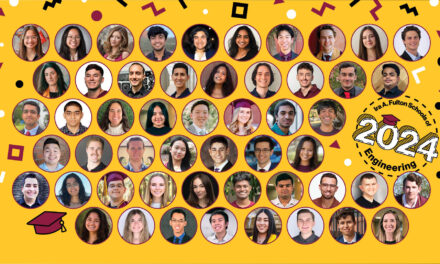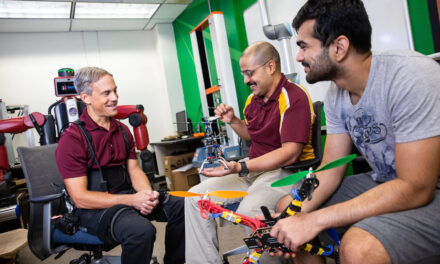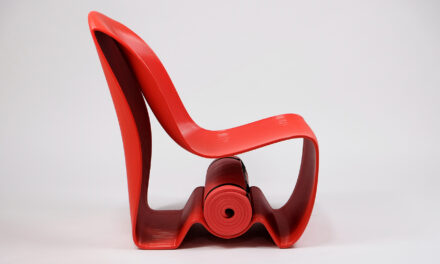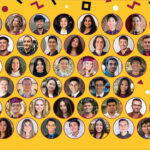
High schoolers get to SEE engineering’s bigger picture
Juniors and seniors from migrant communities learn how the many disciplines of engineering explored at the Ira A. Fulton Schools of Engineering SEE@ASU summer program fit their interests

Above: High school juniors and seniors from a variety of backgrounds, including students from migrant communities, learn about 25 disciplines of engineering and the college experience at SEE@ASU, a weeklong summer camp hosted by the Ira A. Fulton Schools of Engineering at Arizona State University. Graphic by Rhonda Hitchcock-Mast/ASU
Engineering has a lot to offer young people exploring their career possibilities. And young people who come from a variety of backgrounds have a lot to offer the field of engineering.
For high school juniors and seniors, the Ira A. Fulton Schools of Engineering at Arizona State University offers a weeklong immersive experience called SEE@ASU to explore the 25 fields of engineering the Fulton Schools offers as undergraduate majors.
“It’s an important camp because it empowers students,” says Nina Loughman, coordinator of undergraduate recruitment and K-12 engineering outreach. “High school students choose engineering for many reasons. They may be drawn to it because of their parents’ jobs, because they’re good at math or science, or other reasons. This camp provides substance to make an informed decision by narrowing down their interests in engineering.”
Typically conducted on ASU’s Tempe campus — giving high schoolers the opportunity to experience college life and live in a residence hall — SEE@ASU has shifted to an online program for the past two summers because of the COVID-19 pandemic. Adapting to a virtual environment, however, has also opened up new opportunities to expand the program’s reach to students who might not otherwise be able to come to campus.
This past summer, the Fulton Schools ran three SEE@ASU camps. Two of those camps brought 54 local high school juniors and seniors to ASU virtually to explore engineering. A new third camp, specifically designed for migrant students, was created in partnership with the ASU Migratory Student Summer Academy program and led by Seline Szkupinski Quiroga, program director in the School of Transborder Studies, an interdisciplinary school within ASU’s College of Liberal Arts and Sciences.
Bringing ASU engineering to the borderlands
Agriculture is a more than $10 billion industry in Arizona. Migrant farmworkers and their families — including more than 10,000 children in Arizona, the nation’s 7th largest population of migrant students — are drawn to rural agriculture areas along the border and throughout the Southwest for work.
The Arizona Department of Education funds programs to help K-12 migrant students throughout the school year, but the department’s leaders also noticed a gap in summer opportunities for this group, especially in the areas of science, math, technology and engineering, or STEM.
For years, Szkupinski Quiroga has worked with the U.S. Department of Education’s Office of Migrant Education through the grant-funded College Assistance Migrant Program for first-year college students. She now also works with the Arizona Department of Education to support K-12 migrant students. Through the new ASU Migratory Student Summer Academy, or MSSA, Szkupinski Quiroga is connecting middle and high school students to the diverse array of educational summer opportunities at ASU.
“We wanted [a summer program] that was designed specifically for migrant students,” Szkupinski Quiroga says. “Their migratory background can be a source of strength and resilience, creativity and innovation. It’s something they can bring into the classroom and [to] this new summer experience.”
Szkupinski Quiroga set out to find STEAM (STEM with the addition of arts) opportunities at ASU that fit this need. She began by pursuing a collaboration with Fulton Schools Associate Professor Shawn Jordan, who had already organized outreach programs making engineering culturally relevant to Navajo students through STEAM-related storytelling. However, the COVID-19 pandemic forced Szkupinski Quiroga to shift from planning an in-person program with Jordan to exploring a different, virtual path with another Fulton Schools program.
“I had never done anything virtual so I looked around to see who at ASU had experience with virtual summer programs and I learned about SEE@ASU,” she says.
Through a partnership with the Fulton Schools SEE@ASU team and MSSA, Loughman and Szkupinski Qurioga developed a weeklong STEM program to enhance migrant students’ math and science skills, engage in applied science, identify strengths and talents, and learn to work cooperatively.
In addition to featuring lessons and projects that drew on the migrant experience, the students were free to speak both English and Spanish during SEE@ASU activities to encourage English language learners to see how STEM transcends language barriers.
Getting hands-on with engineering
Students explored engineering disciplines through hands-on projects taught remotely by ix faculty members from across the Fulton Schools. Each session helped participants learn about opportunities available in specific areas of engineering.
“It can be challenging to make an online format engaging, but the Fulton Schools faculty members put together some really excellent activities,” Loughman says. “All participants were shipped a maker’s kit containing the supplies needed for their hands-on activities.”
Anoop Singh, a lecturer of mechanical and aerospace engineering, two majors within the School for Engineering of Matter, Transport and Energy, taught participants about aerodynamics using balsa wood aircraft.
Maria Elena Chavez-Echeagaray, a lecturer of computer science, a major in the School of Computing and Augmented Intelligence, demonstrated user experience and computer science applications through a live, virtual demonstration
Jeffrey Kleim, an associate professor of biomedical engineering in the School for Biological and Health Systems Engineering, explored the Biomedical Engineering Design Studio with Laboratory Manager Michael Sobrado.
Deana Delp, a lecturer of engineering who teaches in The Polytechnic School, showed students how to construct a smart rain gauge.
Chao Wang, a lecturer of electrical engineering, which is a major in the School of Electrical, Computer and Energy Engineering, guided students in constructing a solar-powered fan.
Mackenzie Boyer, a lecturer of civil and environmental engineering in the School of Sustainable Engineering and the Built Environment, led a water filtration activity.
“I loved the hands-on activities we were able to participate in despite being in a virtual environment,” says Kavya, a senior at Centennial High School who participated in one of the SEE@ASU camps targeted to local high school students. “Experiments are my favorite part of learning, so these activities really helped me to understand each individual engineering discipline.”
Boyer’s project — a camp favorite — introduced the lesser-known discipline of environmental engineering. Students were encouraged to collect a water source from an area around their homes, or create their own dirty water source, which they then learned to purify.
“That project highlighted a whole realm of engineering related to agriculture and water applications,” which were familiar to many of the migrant students, Loughman says.
The students also worked on a weeklong group project during the camp. The students were tasked with a challenge unique to their own experiences: using engineering to develop a solution that would help people in the migrant community.
“They all had different ideas — things around language use, physical labor, learning models and navigating the internet,” Szkupinski Quiroga says. “It was exciting to see how the Fulton Schools approach to engineering is not something far removed from their lives. They can see issues in their communities and in their parents’ work lives and how engineering can solve those things.”
More than a fun week
In addition to learning about engineering, the purpose of SEE@ASU is to demystify the pathway to and experience of college. SEE@ASU participants also get their application fee waived if they apply to ASU. Current engineering undergraduate majors and non-STEM majors were on hand to talk to the high schoolers as near peers in candid question and answer sessions.
During the camp, migrant students worked with counselors who had participated in the ASU CAMP Scholars program, many of whom are engineering majors and all of whom are also migrant students.
“It made a difference to have someone close to their age to serve as role models who come from the same community and are now at ASU,” Szkupinski Quiroga says. “They could talk about what it’s like deciding to leave home” and also see how ASU is welcoming to migrant students like them.
MSSA also provided arts and cultural opportunities on weekends, bookending the SEE@ASU camp with a curriculum designed by Herberger Institute for Design and the Arts graduate students to foster the students’ leadership skills.
“For someone to be the first one in their family to leave the rural community, to make that decision to go to ASU, you need to have that leadership potential,” Szkupinski Quiroga says.
With the inaugural MSSA and SEE@ASU summer camp collaboration complete, Loughman says she and her team hope to be able to invite migrant students to campus next year to gain the full benefit of experiencing life on a college campus.








































